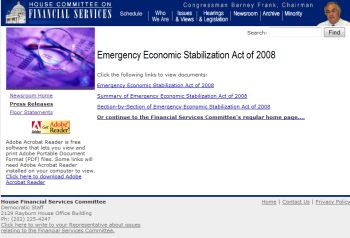The House Financial Services Committee has released a document that details the Emergency Economic Stabilization Act of 2008, also being referred to as “EESA 2008” or simply “EESA”.

If you do not have the time to read the entire entire 100 page PDF document, Light of Reason has summarized the important parts of it below:
I. Stabilizing the Economy
The Emergency Economic Stabilization Act of 2008 (EESA) gives the Secretary of the Treasury up to $700 billion to buy mortgages and assets of financial institutions that are making it difficult for us to access credit. EESA 2008 establishes a program that allows companies to insure their
troubled assets.
II. Homeownership Preservation
EESA 2008 requires that the Treasury modify bad loans wherever possible to help American families keep their homes. EESA 2008 directs other federal agencies to modify loans that they own or control. EESA 2008 updates the “HOPE for Homeowners” program. EESA 2008 expands eligibility and increases
the tools available to the Department of Housing and Urban Development to help more
families keep their homes.
III. Taxpayer Protection
Taxpayers are not expected to pay for Wall Street’s mistakes. EESA 2008 requires companies that sell their bad loans to the government to provide warrants so that taxpayers will benefit from future growth these companies may experience as a result of participation in the program. EESA 2008 requires the President of the United States to submit legislation that covers losses to taxpayers resulting from EESA 2008 from financial institutions.
IV. No Windfalls for Executives
Executives who made bad decisions are not allowed to dump their bad assets on
the government and then walk away with millions of dollars in bonuses. In order to
participate in EESA 2008, companies will lose certain tax benefits. Companies must also limit some executive pay. In addition, EESA 2008 limits “golden parachutes” and requires that unearned bonuses be returned.
V. Strong Oversight
Rather than giving the Treasury all the funds at once, EESA 2008 gives the Treasury
$250 billion right now, then requires the President of the United States to certify that additional funds are needed ($100 billion, then $350 billion subject to Congressional disapproval). The
Treasury must report on the use of the funds and the progress in addressing the crisis.
EESA 2008 establishes an Oversight Board so that the Treasury cannot act in an arbitrary
manner. EESA 2008 also establishes a special inspector general to protect against waste, fraud and
abuse.
